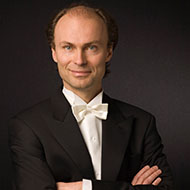At a Glance
IVES
Symphony No. 4 1916/24 | 31 mins
From a 1927 program note gleaned from conversations with the composer: “This symphony . . . consists of four movements—a prelude, a majestic fugue, a third movement in comedy vein, and a finale of transcendental spiritual content. The aesthetic program of the work is . . . the searching questions of What? and Why? which the spirit of man asks of life.” Ives would later add to this a comment of his own: “The last movement (which seems to me the best, compared with the other movements, or for that matter with any other thing I’ve done) . . . covers a good many years. . . . In a way [it] is an apotheosis of the preceding content, in terms that have something to do with the reality of existence and its religious experience.” LISTEN FOR: The texture of this symphony is threaded through with strands based on old hymns that were enormously popular in their day and continue to find their place in Gospel-oriented Protestant churches.
Beethoven
Violin Concerto in D major 1806 | 42 mins
Beethoven and Franz Clement first met in 1794, when the composer added his signature to the violin prodigy’s 415-page book of souvenirs “dedicated to the eternal remembrance of his travels.” Only thirteen, Clement had already covered much of Europe as a concert soloist. By the time he introduced Beethoven’s Violin Concerto in 1806, a work he asked the composer to write for him, Clement was widely regarded as one of Europe’s most outstanding violinists. DID YOU KNOW? Despite Clement’s undisputed talents, this extraordinarily difficult and novel work was not one of Beethoven’s immediate successes. It was only much later—in 1844—that this piece took its place as an indispensable part of the violin repertory, when it was performed by the twelve-year-old violinist Joseph Joachim. Conducting the orchestra at that performance was none other than Felix Mendelssohn!
Jeanette Yu is Director of Publications at the San Francisco Symphony.

